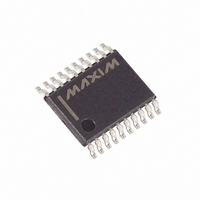MAX1147BCUP+ Maxim Integrated Products, MAX1147BCUP+ Datasheet - Page 23

MAX1147BCUP+
Manufacturer Part Number
MAX1147BCUP+
Description
IC ADC 14BIT 116KSPS 20-TSSOP
Manufacturer
Maxim Integrated Products
Datasheet
1.MAX1147BEUP.pdf
(25 pages)
Specifications of MAX1147BCUP+
Number Of Bits
14
Sampling Rate (per Second)
116k
Data Interface
MICROWIRE™, QSPI™, Serial, SPI™
Number Of Converters
1
Power Dissipation (max)
879mW
Voltage Supply Source
Single Supply
Operating Temperature
0°C ~ 70°C
Mounting Type
Surface Mount
Package / Case
20-TSSOP
Lead Free Status / RoHS Status
Lead free / RoHS Compliant
High-frequency noise in the V
the device’s high-speed performance. Bypass the sup-
ply to the digital ground with 0.1µF and 4.7µF capacitors.
Minimize capacitor lead lengths for best supply-noise
rejection. Connect a 10Ω resistor in series with the 0.1µF
capacitor to form a lowpass filter when the power supply
is noisy.
Integral nonlinearity (INL) is the deviation of the values
on an actual transfer function from a straight line. This
straight line can be either a best-straight-line fit or a line
drawn between the end points of the transfer function,
once offset and gain errors have been nullified. The
static linearity parameters for the MAX1146–MAX1149
are measured using the end-point method.
Differential nonlinearity (DNL) is the difference between
an actual step width and the ideal value of 1 LSB. A
DNL error specification of less than 1 LSB guarantees
no missing codes and a monotonic transfer function.
Aperture jitter (t
the time between the samples. Aperture delay (t
the time between the rising edge of the sampling clock
and the instant when an actual sample is taken.
For a waveform perfectly reconstructed from digital sam-
ples, signal-to-noise ratio (SNR) is the ratio of full-scale
analog input (RMS value) to the RMS quantization error
(residual error). The ideal, theoretical minimum analog-
to-digital noise is caused by quantization error only and
results directly from the ADC’s resolution (N bits):
In reality, there are other noise sources besides quanti-
zation noise: thermal noise, reference noise, clock jitter,
etc. SNR is computed by taking the ratio of the RMS
signal to the RMS noise, which includes all spectral
components minus the fundamental, the first five har-
monics, and the DC offset.
SNR = (6.02 x N + 1.76)dB
AJ
) is the sample-to-sample variation in
______________________________________________________________________________________
Differential Nonlinearity
Signal-to-Noise Ratio
DD
Integral Nonlinearity
Aperture Definitions
power supply degrades
Definitions
Multichannel, True-Differential,
AD
) is
Signal-to-noise plus distortion (SINAD) is the ratio of the
fundamental input frequency’s RMS amplitude to RMS
equivalent of all other ADC output signals.
Effective number of bits (ENOB) indicates the global
accuracy of an ADC at a specific input frequency and
sampling rate. An ideal ADC’s error consists of quanti-
zation noise only. With an input range equal to the full-
scale range of the ADC, calculate the ENOB as follows:
Total harmonic distortion (THD) is the ratio of the RMS
sum of the first five harmonics of the input signal to the
fundamental itself. This is expressed as:
where V
V
harmonics.
Spurious-free dynamic range (SFDR) is the ratio of RMS
amplitude of the fundamental (maximum signal compo-
nent) to the RMS value of the next-largest distortion
component.
TRANSISTOR COUNT: 5589
PROCESS: BiCMOS
Pages changed at Rev 2: 1, 20, 23, 25.
5
are the amplitudes of the 2nd- through 5th-order
THD
SINAD(dB) = 20 x log (SignalRMS / NoiseRMS)
1
=
Serial, 14-Bit ADCs
is the fundamental amplitude, and V
20
ENOB = (SINAD - 1.76) / 6.02
×
Signal-to-Noise Plus Distortion
Spurious-Free Dynamic Range
log
⎛
⎜
⎜
⎝
Total Harmonic Distortion
Effective Number of Bits
V
2
2
+
Chip Information
Revision History
V
3
2
+
V
1
V
4
2
+
V
5
2
2
⎞
⎟
⎟
⎠
through
23






